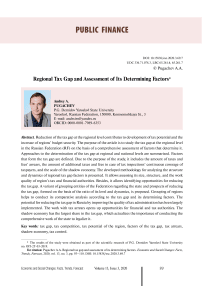Regional tax gap and assessment of its determining factors
Автор: Pugachev Andrey A.
Журнал: Economic and Social Changes: Facts, Trends, Forecast @volnc-esc-en
Рубрика: Public finance
Статья в выпуске: 3 т.13, 2020 года.
Бесплатный доступ
Reduction of the tax gap at the regional level contributes to development of tax potential and the increase of regions’ budget security. The purpose of the article is to study the tax gap at the regional level in the Russian Federation (RF) on the basis of a comprehensive assessment of factors that determine it. Approaches to the determination of the tax gap at regional and national levels are summarized. Factors that form the tax gap are defined. Due to the purpose of the study, it includes the amount of taxes and fees’ arrears, the amount of additional taxes and fees in case of tax inspections’ continuous coverage of taxpayers, and the scale of the shadow economy. The developed methodology for analyzing the structure and dynamics of regional tax gap factors is presented. It allows assessing its size, structure, and the work quality of region’s tax and financial authorities. Besides, it allows identifying opportunities for reducing the tax gap. A variant of grouping entities of the Federation regarding the state and prospects of reducing the tax gap, formed on the basis of the ratio of its level and dynamics, is proposed. Grouping of regions helps to conduct its comparative analysis according to the tax gap and its determining factors. The potential for reducing the tax gap in Russia by improving the quality of tax administration has been largely implemented. The work with tax arrears opens up opportunities for financial and tax authorities. The shadow economy has the largest share in the tax gap, which actualizes the importance of conducting the comprehensive work of the state to legalize it.
Tax gap, tax competition, tax potential of the region, factors of the tax gap, tax arrears, shadow economy, tax control
Короткий адрес: https://sciup.org/147225470
IDR: 147225470 | DOI: 10.15838/esc.2020.3.69.7
Список литературы Regional tax gap and assessment of its determining factors
- Voroshilov N.V., Gubanova E.S. Territorial differentiation and mechanism for its reduction. Ekonomicheskie i sotsial’nye peremeny: fakty, tendentsii, prognoz=Economic and Social Changes: Facts, Trends, Forecast, 2018, vol. 11, no. 6, pp. 57–72. DOI: 10.15838/esc.2018.6.60.4. (in Russian)
- Podviezko A., Parfenova L., Pugachev A. Tax competitiveness of the new EU member states. Journal of Risk and Financial Management, 2019, no. 12 (1), 34, pp. 1–19. DOI:10.3390/jrfm12010034.
- Avdiyskiy V.I., Bezdenezhnykh V.M. The structure of financial flows in the shadow economy and methods of their assessment. Ekonomika. Nalogi. Pravo=Economics, Taxes & Law, 2018, no. 11(5), pp. 6–15. DOI: 10.26794/1999-849X-2018-11-5-6-15. (in Russian)
- Rotz W., Murlow J., Falk E. The 1995 Taxpayer compliance measurement program (TCMP). Sample redesign: A case history. In: Turning Administrative System into Information System. Internal Revenue Service, Washington, 1994. Pp. 121–126.
- Mironova O.A., Hanafeev F.F. Tax gap: Problems of definition and regulation. Voprosy regional’noi ekonomiki=Voprosy regionalnoj ekonomiki, 2016, no. 2 (27), pp. 112–115. (in Russian)
- Shakirova D.Yu., Zas’ko V.N. The tax gap: Peculiarities of defining and world experience. Rossiiskoe predprinimatel’stvo=Russian Journal of Entrepreneurship, 2014, vol. 15, no. 18, pp. 163–170. (in Russian)
- Raczkowski K., Mro’z B. Tax gap in the global economy. Journal of Money Laundering Control, 2018, no. 21(4), pp. 545–554. DOI: 10.1108/JMLC-12-2017-0072.
- The concept of tax gaps. Report II: Corporate income tax gap estimation methodologies. In: Taxation Papers. Working Paper №73 – 2018. Fiscalis Tax Gap Project Group (FPG/041). Brussels, July 2018. 112 p.
- Kosova T., Slobodyanyuk N., Polzikova H., Šatanová A. Тax gap management: Theory and practice. Економiчний часопис-XXI, 2018, no. 11-12 (174), pp. 22–28. DOI: https://doi.org/10.21003/ea.V174-04.
- Laffer A., Seymour J. The Economics of the Tax Revolt. Harcourt Brace Jovanovich, 1979. 138 p.
- Alfirman L. Estimating stochastic frontier tax potential: Can Indonesian local governments increase tax revenues under decentralization. In: Center for Economic Analysis Working Paper, 2003, no. 03-19. 37 p.
- Bird R.M., Martinez-Vazquez J., Torgler B. Societal Institutions and Tax Effort in Developing Countries. Toronto, University of Toronto, 2004. 195 p.
- Filippovich E.S. Shklyarova M.A., Kosach O.F., Naumchik S.O. Effektivnost’ deyatel’nosti nalogovykh organov: otsenka i rezervy povysheniya [Efficiency of Tax Authorities Activity: Assessment and Reserves for Improvement]. Ed. by E.S. Filippovich. Minsk: BGATU, 2017. 256 p.
- Murphy R. The Tax Gap, Tax Evasion in 2014 – and What Can be Done about it. Public and Commercial Services Union, London, September, 2014. Available at: http://openaccess.city.ac.uk/id/eprint/16565/1/PCSTaxGap2014Full.pdf (accessed: 30.11.2019).
- Raczkowski K. Measuring the tax gap in the European economy. Journal of Economics and Management, 2015, no. 21 (3), pp. 58–72.
- Roshchupkina, V.V. The tax burden index as an indicator of the effectiveness of fiscul measures taken by the government. Ekonomika. Nalogi. Pravo=Economics, Taxes & Law, 2016, no. 2, pp. 133–141. (in Russian)
- Suslina, A.L., Leukhin, R.S. Shadow economy fight in Russia: Some aspects of common problems. Finansovyi zhurnal=Financial Journal, 2016, no. 6, pp. 46–61. (in Russian)
- Fedotov, D.Yu., Nevzorova, E.N., Orlova, E.N. A tax method to calculate the value of the shadow economy of Russian regions. Regional’naya ekonomika: teoriya i praktika=Regional Economics: Theory and Practice, 2017, vol. 15 no. 11, pp. 2015–2032. (in Russian)
- Povarova, A.I. Problems related to regional budgeting amid fiscal consolidation. Ekonomicheskie i sotsial’nye peremeny: fakty, tendentsii, prognoz=Economic and Social Changes: Facts, Trends, Forecast, 2018, vol. 11, no. 2, pp. 100–116. DOI: 10.15838/esc.2018.2.56.7. (in Russian)


